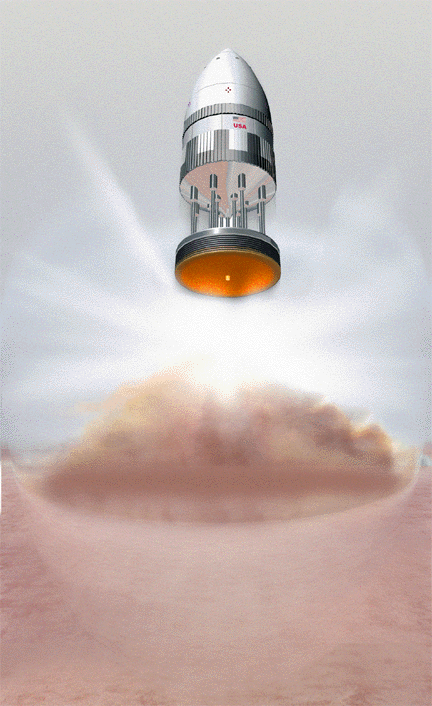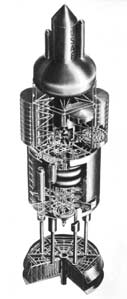Project Orion
Shortly after the first atomic
bomb tests at trinity Stanislaw Ulam, co-inventor of the hydrogen bomb,
started thinking about using bombs to propel something into ballistic tragectory.
The idea lay mostly dormant until 1957 when General Atomic, a division General
Dynamics Corporation, started Project Orion and set a team of physicist’s
engineers and mathematicians to work on it. The project was led
by Ted Taylor, a physicist who was known as one the most brilliant designers
of nuclear weapons. He later became become a leading voice warning of the
dangers of nuclear proliferation.
Others notable figures involved in the project were Freeman Dyson,
Stanislaw Ulam, Marshall Rosenbluth, and Hans Bethe.
Orion has been described as an external
combustion nuclear pulse propulsion system. The spaceship consists
of a large pusher plate attached to the spaceship by shock absorbers.
Nuclear bombs are dropped through the pusher plate and exploded several
hundred feet behind the ship. The repeated explosions would accelerate
the ship into space. Velocities and payloads would have been much
greater than those allowed by conventional chemical rockets. Sizes
of the planned Orion ships varied, many were in the range of 135 feet in
diameter and 200 feet tall, weighing 4000 tons. Super-Orion had a
diameter of 400 meters and was powered by hydrogen bombs; it was the largest
ship that could take off from earth’s surface.
Orion was never built, many technical
difficulties remained unsolved, but what stopped the project was the
test ban treat of 1963. Interestingly, Freeman Dyson helped negotiate
the treaty that meant the end of project Orion
Project Orion was undertaken by
a private corporation on contract for the Atomic Energy Commission and
the Defense Advanced Research Projects Agency. Later it was funded
by the Air Force. The Project had little military value, the people
working on Orion saw it as a way to explore and colonize space. In
his “Space Travelers Manifesto” of 1958, Freeman Dyson wrote:
“1. There are more things in heaven and
earth than are dreamed of in our present day science, and we shall only
find out what they are if we go out and look for them.
2. It is in the long run essential to the growth
of any new and high civilization that small groups of people can escape
from their neighbors and from their governments, to go and live as they
please in the wilderness. A truly isolated, small, creative society
will never again be possible on this planet.
3. We have for the first time imagined a way
to use the huge stockpiles of our bombs for a better purpose than for
murdering people. Our purpose and our belief is that the bombs
which killed and maimed people at Hiroshima and Nagasaki shall one day
open the skies to man.”

